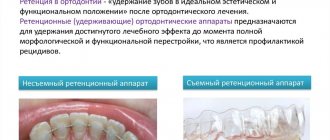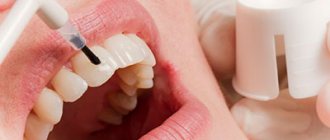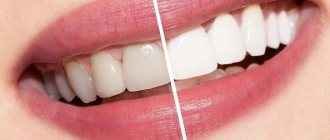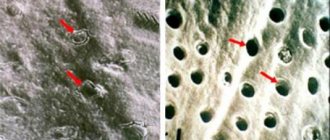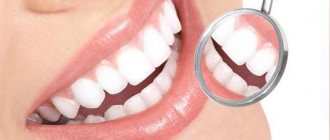It’s done - you have become the owner of a Hollywood smile by undergoing a teeth whitening procedure. But not everything is so simple - in order to maintain snow purity, it is necessary to avoid exposure to coloring pigments contained in some foods and drinks. So you will have to go on a diet for a while so as not to reduce the doctor’s efforts to zero.
Aggressive dyes or chromogens enter the oral cavity with juices, coffee, tea and other liquids, as well as sweets, sauces, seasonings, and vegetables. Chromogens contained in food and drinks, when they get on the surface of the tooth, have a coloring effect. At the same time, not only bright fruits, berries, juices, but also overly sour dishes can deprive a snow-white smile - they make the enamel more susceptible to changes in natural color.
Natural tooth color
We are blinded by snow-white smiles from screens, magazine pages and billboards. White teeth help you feel more confident and look younger, but is it really possible to get a Hollywood smile without veneers and whitening?
Tooth enamel has a natural white tint. However, the layer of dentin located underneath has a yellowish color, which shines through the enamel in almost everyone, but more so in those whose enamel is naturally thinner or translucent. So a yellow or grayish tint is the norm.
The dentist will help determine the natural tone of the teeth, which you can focus on in order to control it in the future. To maintain the shade of your teeth, it is important to limit the consumption of coloring foods and drinks with a similar effect.
Ask a Question
Preventing tea stains on teeth
Tea lovers need to use a special whitening paste. A good option is to purchase ASEPTA PLUS, which provides gentle whitening and protection against plaque formation and unwanted pigmentation.
Advantages of ASEPTA PLUS paste:
- a unique multi-stage cleaning system that does not damage the enamel;
- content of potassium citrate and hydroxyapatite, which mineralize weakened enamel.
- calamus and eleutherococcus extracts strengthen the gums and help maintain healthy mucous membranes;
- Possibility of daily use.
Products that stain teeth
The main list of coloring products that should be limited in consumption:
- very sour fruits and berries, as well as juices from them;
- richly colored sauces;
- chocolate and desserts with cocoa;
- curry and other seasonings.
Be sure to avoid coloring products after a light dental filling: immediately after its installation, the risk of staining increases.
Vegetables, fruits and berries
Blueberries, blackberries, cherries, pomegranates and other brightly colored fruits can stain enamel. Light-colored fruits, such as white grapes and apples, are less dangerous. True, there is one thing: sour apple juice stains teeth not because of chromogens, but precisely because of acid. But cherries stain teeth precisely because of the pigments contained in the pulp.
Teeth-safe fruits and berries:
- banana - does not stain teeth;
- sweet pears;
- melon;
- sweet strawberry.
Sauces
The following stain enamel more strongly than others:
- Balsamic vinegar. It can make a delicious salad dressing and pigmentation for enamel.
- Soy sauce. Whether a product stains your teeth or not can be seen immediately after use. Dark spots on the enamel are an inevitable consequence of excessive consumption of this sauce.
Switch to light or creamy sauces, brush your teeth and rinse your mouth immediately after eating.
Seasonings
For example, curry and turmeric, the yellow and brown pigments of which instantly eat into the enamel.
Sweets
Eating your favorite sweets, such as candy, gummies, chocolate or popsicles, can change the color of your tongue and teeth. The good news is that if you don't eat these treats often, they probably won't do much harm.
Benefits of tea
Green hour has a very beneficial effect on the oral cavity: it improves blood circulation in the gums and also strengthens the teeth. Thanks to the beneficial microelements contained in tea (fluoride, iron, zinc, calcium), you can even avoid inflammation of the gums and tissues surrounding the tooth, and also slightly whiten your teeth. Naturally, tea cannot make it snow-white like after a teeth whitening procedure in Minsk
Scientists have proven that people who regularly drink green tea visit the dentist much less often. This, of course, does not mean that lovers of this drink do not suffer from oral diseases; it’s just that tea has a kind of preventive effect, since it is considered a good antibacterial agent against caries. Why not help on the farm? Saves us money on dental treatment under anesthesia or any other dental procedures that help maintain healthy teeth. And for those who suffer from halitosis, or, in other words, bad breath, green tea can easily replace chewing gum or mints. In general, solid advantages, and that’s all.
What drinks stain teeth?
Not only food, but also drinks can change the color of your smile.
Tea and coffee
Your favorite hot drinks contain tannins (tannin), which cause coloring.
Black and red tea are healthy drinks, but may not be the best choice for keeping your smile white. Moreover, its effect on enamel is stronger than that of coffee, especially when it comes to strong black tea. However, adding milk or cream helps prevent stains.
Guilt
Red wine is an acidic drink known for its rich color. Changes the shade of teeth towards gray. But white wine, which has even more acid, can do the same. It damages the enamel, making it rougher, causing the dentin layer to show through.
Carbonated drinks
This includes soda, Coca-Cola, lemonade. Kvass also stains your teeth, so you should avoid drinking the drink after treatment at the dentist. The same applies to sports drinks, which at first glance seem harmless. Drinking water during exercise is the best choice.
To drink or not to drink
- Coffee
It contains (especially if you prefer soluble) aggressive coloring pigments. They can easily turn even perfectly clean teeth yellowish and cover the enamel with dark spots. The dyes contained in coffee beans are stronger than tobacco smoke.
Our advice: to minimize the effect of drinking this drink, add milk to it. This will soften the taste of coffee and reduce the negative effects of pigments.
- Tea
Not only black tea, but also green tea, as well as any herbal tea, can stain your teeth - this has been proven in recent studies. If you don't believe me, look at the brownish layer that remains on the bottom and sides of your mug if you don't wash it for a long time. The same thing can happen to your enamel.
Our advice: if you, like a true Englishman, cannot miss the five-o-clock, choose green or white tea and do not brew it for a long time - 1-3 minutes is enough. By the way, the drink should not be too hot - spare your teeth. High temperature enhances the effect of dyes and can cause hyperesthesia - increased sensitivity of enamel to irritants.
- Red wine
It contains tannins and chromogens - compounds that lead to a change in natural color. And polyphenols only contribute to intense coloring.
Our advice: give up red wine and replace it with white or rosé. Another option is to use a special paste that has a whitening effect immediately after drinking the drink.
- Soda, juices and fruit drinks
Soda contains a lot of phosphoric acid. We have already found out that the more acidity, the less chance of maintaining a snow-white smile. Colored drinks containing dyes and harmful additives are especially dangerous. Together they can lead to gradual destruction of the enamel.
Richly colored juices and fruit drinks (from tomatoes, cranberries, beets, currants, etc.) also contain a lot of coloring pigments, which can make your teeth a shade darker.
Our advice: drink bright drinks only through a straw - this will help minimize the contact of chromogens with the enamel. Afterwards, rinse your mouth thoroughly with warm water.
How to reduce the coloring effect: expert advice
Simple measures to help keep your teeth white:
- Find alternative products. You may not want to eliminate all foods and drinks that stain your teeth from your diet. Many of them, such as blueberries, blackberries and tomato sauce, are rich in antioxidants. So continue to eat them, but in limited quantities, or choose other sources of nutrients: cauliflower, apples, grapefruit and melon.
- Use a straw. Drink sodas, juices, and iced tea through a straw.
- Rinse your mouth immediately after eating. If you don't have a toothbrush handy, chew sugarless gum immediately after eating.
- Eat plenty of crunchy fruits and vegetables (apples, carrots and celery) as they increase salivation and cleanse teeth by acting as natural stain removers.
- Brush your teeth twice daily and as directed by your dentist.
We have listed which products stain teeth, but this is not a reason to give them up 100%.
Clinical researches
Clinical studies have proven that regular use of ASEPTA professional toothpaste improved the condition of the enamel by 64% and reduced tooth sensitivity by 66% after just 4 weeks.
Sources:
- Report on the determination/confirmation of the preventive properties of personal oral hygiene products “ASEPTA PLUS” Remineralization doctor-researcher A.A. Leontyev, head Department of Preventive Dentistry, Doctor of Medical Sciences, Professor S.B. Ulitovsky First St. Petersburg State Medical University named after. acad. I.P. Pavlova, Department of Preventive Dentistry
- Report on determining/confirming the preventive properties of toothpaste “ASEPTA PLUS” COFFEE and TOBACCO Author: doctor-researcher A.A. Leontyev, head Department of Preventive Dentistry, Doctor of Medical Sciences, Professor S.B. Ulitovsky. First St. Petersburg State Medical University named after. acad. I.P. Pavlova, Department of Preventive Dentistry
- Report on determining/confirming the preventive properties of toothpaste “ASEPTA PLUS” GENTLE WHITENING” Author: doctor-researcher A.A. Leontyev, head Department of Preventive Dentistry, Doctor of Medical Sciences, Professor S.B. Ulitovsky First St. Petersburg State Medical University named after. acad. I.P. Pavlova, Department of Preventive Dentistry
- Clinical and laboratory assessment of the influence of domestic therapeutic and prophylactic toothpaste based on plant extracts on the condition of the oral cavity in patients with simple marginal gingivitis. Doctor of Medical Sciences, Professor Elovikova T.M.1, Candidate of Chemical Sciences, Associate Professor Ermishina E.Yu. 2, Doctor of Technical Sciences Associate Professor Belokonova N.A. 2 Department of Therapeutic Dentistry USMU1, Department of General Chemistry USMU2
- Clinical studies of antisensitive toothpaste “Asepta Sensitive” (A.A. Leontyev, O.V. Kalinina, S.B. Ulitovsky) A.A. LEONTIEV, dentist O.V. KALININA, dentist S.B. ULITOVSKY, Doctor of Medical Sciences, Prof. Department of Therapeutic Dentistry, St. Petersburg State Medical University named after. acad. I.P. Pavlova
- The role of anti-inflammatory rinse in the treatment of periodontal diseases (L.Yu. Orekhova, A.A. Leontyev, S.B. Ulitovsky) L.Yu. OREKHOVA, Doctor of Medical Sciences, Prof., Head of Department; A.A. LEONTIEV, dentist; S.B. ULITOVSKY, Doctor of Medical Sciences, Prof. Department of Therapeutic Dentistry of St. Petersburg State Medical University named after. acad. I. P. Pavlova
It's all due to age or neglect
One of the reasons why teeth turn yellow in both adults and children may be the food they eat. If you prefer foods with bright colors (chocolate, sauces, beets, drinks), or drink strong tea or coffee, you are unlikely to be able to keep your smile snow-white. An incorrect diet filled with foods with dyes is practically the only reason why teeth turn yellow in teenagers.
For people over 18, it becomes more difficult to achieve a snow-white smile - with age, tooth enamel becomes thinner, and the color of teeth loses its former brightness. Adults who work in hazardous industries involving volatile substances also suffer from yellowing.
Antibiotics will negatively affect the color of your smile, as well as the course of certain diseases (fluorosis, hemolytic and Addison's diseases).
Another reason why teeth turn yellow in adults is considered to be bad habits, especially smoking, and an important factor is frequent drinking of coffee. Tobacco tars are quickly deposited on the surface of tooth enamel and, accumulating, give the teeth an unpleasant yellow color.
Charge for regular drinks
It would seem that there is nothing reprehensible in a cup of coffee or tea in the morning, afternoon and evening. Most people have long been accustomed to these liquids, although they appeared in our culture, frankly speaking, relatively recently. One way or another, getting too carried away with them can also lead to yellow teeth. By the way, the type and color of tea does not really matter here. For example, the majority today do not even know how to choose the right green tea, opting for advertised, unnatural varieties with an abundance of artificial coloring substances. Suffice it to say that the popular so-called “milk oolong” is a chemical that the Chinese themselves will never drink.
“White” diet after teeth whitening: what can you eat?
It is highly desirable that the menu includes products that benefit dental tissues, and not just those that are safe for enamel in terms of staining. The diet should contain a lot of calcium and fluoride-containing foods; they will help strengthen the enamel and prevent its increased sensitivity, which may appear during the first time after whitening procedures. It is recommended to include in your daily menu:
- Dairy products that do not contain dyes and fruit fillers: cottage cheese, milk, yogurt, butter.
- Sea fish and other seafood. Moreover, when buying cut fish, you should make sure that it is not tinted with food coloring (dyed fish leaves distinct pink marks on the packaging or plate).
- Pears, bananas, pineapple - any fruit that does not contain a large amount of fruit acids and cannot stain the enamel.
- Asparagus, celery, cauliflower.
- Chicken or turkey meat.
- Rice, potatoes, champignons and porcini mushrooms.
- Bread and bakery products made from wholemeal white flour.
- Egg whites. Yolks are excluded from the diet because they also stain the enamel.
This “food set” will allow you to eat well, get all the substances your body needs, and at the same time will not harm your enamel.


